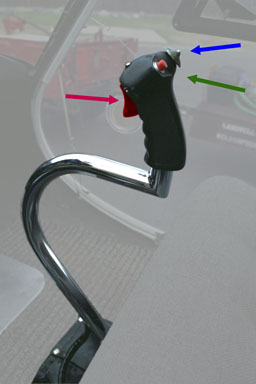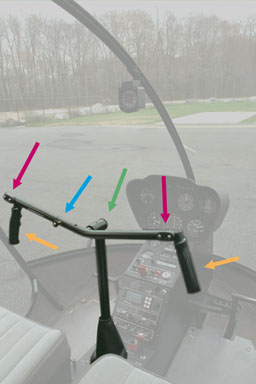

The arrows are pointing to 3 controls on the F28 cyclic.
The red arrow on the left is pointing at the trigger switch. This is used for transmitting on the radio. Normally, the first click would activate the intercom so the pilot could talk to the other people on board the helicopter, and the second click (i.e. all the way in) would actually transmit on the radio. In our F28, the first click doesn't do anything because we have a voice activated intercom, and so the switch isn't required.
On the right side, the upper arrow which is blue points at the trim switch. This is called a "coolie hat" because it has a shape similar to that of an asian peasant's hat. It is like a joystick, and can be moved up, down, left and right. The pilot uses this to neutralize stick force. If air loads from the rotor system are holding the cyclic to the left, the pilot can push the trim switch to the right. This runs an electric motor which will tension a spring which will tend to hold the stick to the right. If the pilot uses the trim correctly, the cyclic will stay where it is even if the pilot were to let go. Everytime the airspeed is changed, or a different cross wind is encountered, the pilot must retrim to remove the stick forces.
The bottom arrow on the right side points to the cargo release switch. This could be used for other things if no cargo hook is installed. We don't have a cargo hook on this helicopter, but we haven't bothered to hook this button to anything else, so it doesn't do anything for us. If this was connected to a cargo release hook, pushing this button would cause an external load suspended beneath the helicopter on a cable to be released from the hook.
The curve in the cyclic allows it to move back quite a few inches before it hits the seat, yet the handle is right where it is comfortable for the pilot to reach.
Compare the Robinson R22 Cyclic, which is a radically different design than most other cyclics:

There are a few things to note, which is why there are so many arrows! The orange arrows point to the hand grips. The green arrow points to the pivot point for the cyclic. The hand grips can be teetered up and down around this pivot, like a see saw. If one hand grip goes up, the other has to go down, they can't move independently.
The blue arrow points to the pin which allows the left hand grip assembly to be removed. (The left hand collective and pedals can also be removed).
The red arrows point to each set of intercom and transmit buttons. Unlike the Enstrom, the Robinson R22s do not normally have a voice activated intercom. You have to push your intercom button in order to speak to the other person in the helicopter. On the left hand floor, there is a foot switch which allows the person in the left hand to either use the cyclic or floor mounted switch to activate the intercom. The foot switch allows use of the intercom when the left hand grip is removed from the cyclic. It is also used by instructors sitting on the left side, so that they can talk to the pilot receiving instruction without the instructor having to push on the cyclic.
The second switch on each side of the cyclic is the radio transmit button. When the left hand cyclic assembly is removed, there is no way for the person in the left hand seat to transmit on the radio.
Most people react negatively to the Robinson style cyclic at first. However, as you get used to it, you realize that there are several advantages to this arrangement. Personally, I like having the column coming up from the floor where it is, away from hitting my legs. I just wish that each hand grip could move up and down independently so that each pilot could set the hand grip height to a comfortable position. As it is, instructors end up learning to fly with their arm high in the air so that the student pilot can rest his arm on his leg.